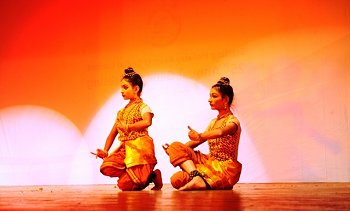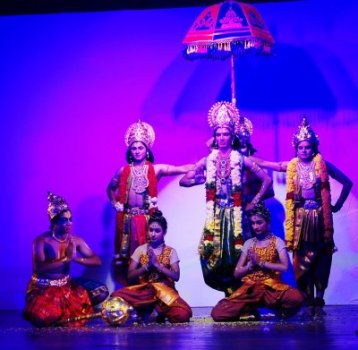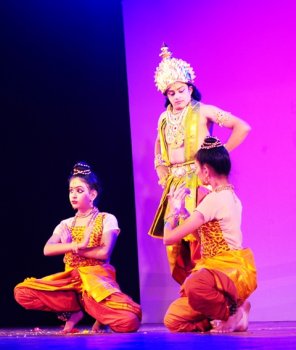
|   |

|   |
Bharatanatyam dance drama Lava Kusa Text & pics: Balayogi e-mail: balayogiv@gmail.com January 19, 2013 The theme of the Bharatanatyam drama Lava Kusa is a well known and oft repeated story. So presenting such theme subjects one to highly unsettling identity's 'double implication' uniqueness and sameness. If it is on sameness then it becomes redundant and why should anyone watch the same story played by a new bunch of artistes. But if it is on the side of uniqueness then it needs to be acknowledged, analyzed and appreciated. This Bharatanatyam drama performed at Chinmaya Heritage Centre on January 14 with a crowd of 400 plus audience vociferously applauding at the end of every scene obviously placed the show in the second category of something unique.  As a critic, I decided to analyse the creative genius of this entire team. It was in the very treatment of manifesting certain unique aspects and originality in all aspects. Original lyrics penned by Ashwin Kumar Iyer, the excellent music composed by PB Srirangachari, imaginative choreography by Mahalakshmi Ashwin and the energetic and creative performance by the entire team of Bharatanatyam specialists from Kalakshetra and Tapas Foundation with a concomitant harmonizing orchestra made it very special. To start with there was the absence of pre-performance synopsis in western linguistic system. There were not many scene settings or props to convey the character depiction. Instead, almost all scenes enchained one after the other were dramatic due to the effective rendering of their contrasting moods and the emotions of every character which were well depicted lyrically, musically and through appropriate and powerful abhinaya and hastamudras. Even lighting was used very carefully only to recreate the effects of distance, space, portray personalities from different milieus namely, those from the royal abode (Rama and his brothers) and those living in an ashram (Lava, Kusa and Valmiki). Battle scenes were set in suitable nadais (rhythmic patterns) in chatusram, mishram and kantam with appropriate raga patterns. On a broader evaluation this can be classified on the basis of narrative – choreographic dramatic structure as suspended: the story climbs fast to a dramatic climax, turns down a bit to climb again, and does this over and over. For other categories see foot note [1] Bharatanatyam’s key feature nritta with its complex rhythmic footwork of strikes, extensions, jumps, leaps, intricate patterns made by movement of hands and legs appropriately and not exaggeratedly (then it becomes too theatrical) all stemming from an extended and dynamic torso with controlled movements creating perfect geometry in motion was well portrayed by both generating and releasing the emotion of the character of Anjaneya played by Sairam, a senior male Bharatanatyam artiste and the guard of the hermitage of Lava Kusa, played by Malaika. Both characters exhibited special effort or stylization, such as high kicks, leaps, or measured walks. They also manifested how Bharatanatyam requires unaccustomed patterns of muscular exertion and relaxation as well as an unusually intense or sustained expenditure of energy and showed how a dancer may become intensely aware of the force of gravity and of a state of equilibrium or disequilibrium that no one can experience in any other activity. 

The role played by Anjaneya was so vibrant that many could experience kinaesthetically [2] something similar to the physical sensations of the artiste. There was maturity and poise in the character of Valmiki played by Rajesh and Vashista by Jahnavi. The beauty was this hour long briskly paced dance drama was also spiced with sublime incorporation of sculpturesque poses of some characters with appropriate ragas like Sahana accompanying such a scene. Aswamedha horse’s entry, its arrest and struggle with the mask, muscular twists and turns of the artiste Rajesh along with appropriate special effects by Jaykanth reminded one of Chhau [3] dance of eastern India. Here I would be failing in my duty if I do not mention the excellent supportive role played by the entire orchestra: vocal - Sai Sabapathy, violin - KR Suresh, flute - Ragavendran, nattuvangam - Mahalakshmi Ashwin, mridangam -Nagai Nagendran. This production established a unique feature of Indian classical natyams. While globally cultural conventions partly determine the limits of expression (our natya traditions have treasury of several thousand already well defined and codified mudras or gestures etc), any deft artiste can portray any and many complex actions, emotions, and relationships. The word Thala, [Tha + La] is a word coined from Thandavam of Lord Siva and Lasyam of Goddess Parvathi. The percussionist ably portrayed contrasting emotions of aggression and softness. This was enhanced by the wonderful performance of two young girls playing the role of Lava (Niveditha) and Kusa (Manasa Sriram). On the whole a lot of care and co ordination work seem to have been taken to present the show with absolute professionalism, pure classicism and aesthetics. I remembered French poet Stéphane Mallarmé writing that the dancer, “writing with her body ... suggests things which the written work could express only in several paragraphs of dialogue or descriptive prose.” It also helped me to realize that dance can be of a great assistance in clarifying the language of analysis and inculcating understanding of and appreciation for the strong undercurrents that fuel the power of literature. Explanations of tone, the basic concept of rhythm in poetry and prose and variations in rhythm, patterns of syntax, diction, and rhetorical elements such as parallelism, emphasis, subordination, coordination, compression and expansion are deepened when demonstrated through dance movement. Footnote: [1] Other categories of narrative – choreographic dramatic structures a) Circular: The story begins with the end, develops and finishes as it started. b) Inverted: The story begins with the end and develops progressively to the beginning. c) Flat: There’s no changing in the intensity of actions or no conflict. Just something happens. d) Fragmented: The parts of the story are displayed in disorder. [2] Kinesthesia, or the awareness of the body through sensations in the joints, muscles and tendons, rather than through visual perception, not only defines the dancer’s experience of his own body in movement but also the way in which dance exerts its power over the spectators, who not only see it but also feel an echo of the dancer’s movements and rhythms in their own nerve endings. [3] Chhau is the indigenous natya of Eastern India. It originated as martial art and contains vigorous movements and leaps. They use stylized masks depicting birds, animals and mythological heroes with distinctive features. Balayogi is a music and dance critic. |